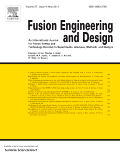
FUSION ENGINEERING AND DESIGN
Scope & Guideline
Shaping the Landscape of Nuclear Energy and Engineering.
Introduction
Aims and Scopes
- Fusion Reactor Design and Engineering:
The journal covers the design and engineering challenges associated with various fusion reactor concepts, including the ITER project and DEMO, focusing on structural integrity, thermal hydraulics, and system integration. - Materials Science and Engineering:
Research on materials for fusion applications is a core focus, including studies on tritium breeding materials, radiation-resistant materials, and innovative manufacturing techniques such as additive manufacturing and welding. - Plasma Physics and Control:
The journal publishes works related to plasma behavior, control mechanisms, and diagnostic techniques essential for effective fusion operation, including studies on plasma stability, disruption mitigation, and advanced diagnostic systems. - Thermal-Hydraulic Systems Analysis:
Research addressing the thermal-hydraulic performance of fusion systems, including cooling systems, heat exchangers, and safety analysis during operational transients. - Neutronics and Radiation Safety:
Contributions related to radiation transport modeling, neutronics analysis, and the assessment of radiation shielding and safety measures for fusion reactors are significant aspects of this journal. - Innovative Technologies and Systems:
The journal emphasizes the development of innovative technologies and systems for fusion reactors, including advanced diagnostics, remote handling systems, and control systems.
Trending and Emerging
- Advanced Manufacturing Techniques:
There is a notable increase in research focused on advanced manufacturing techniques, including additive manufacturing and precision welding, which are critical for producing complex fusion reactor components. - Machine Learning and AI Applications:
The integration of machine learning and artificial intelligence in optimizing fusion reactor operations, diagnostics, and predictive maintenance is a rapidly growing area of research, demonstrating the potential for enhanced data-driven decision-making. - Environmental and Safety Assessments:
Emerging themes include comprehensive assessments of environmental impacts and safety protocols related to fusion energy production, reflecting a broader societal focus on sustainability and safety in energy technologies. - Innovative Cooling Systems:
Research on novel cooling systems, including liquid metal coolants and supercritical CO2, has gained traction as researchers explore efficient heat transfer methods for managing the thermal loads in fusion reactors. - Tritium Management Technologies:
The development of advanced tritium handling and recovery technologies is increasingly emphasized, addressing one of the critical challenges in making fusion energy a practical power source.
Declining or Waning
- Basic Theoretical Research:
There has been a noticeable decline in publications focused on fundamental theoretical studies of plasma physics and nuclear fusion processes as the field increasingly prioritizes applied research and practical engineering solutions. - Conventional Material Studies:
Research on conventional materials without innovative modifications or applications has decreased, as the focus shifts towards advanced materials specifically designed for high-performance applications in fusion reactors. - Small-Scale Experimental Setups:
Research involving small-scale experimental setups or proof-of-concept studies has been less frequent, possibly due to the increasing complexity and scale of fusion projects that require more comprehensive experimental frameworks.
Similar Journals

Plasma and Fusion Research
Igniting Innovation in Plasma and Fusion ResearchPlasma and Fusion Research is a pivotal journal within the realm of plasma science and nuclear fusion, published by the Japan Society of Plasma Science and Nuclear Fusion Research. With an ISSN of 1880-6821, this journal serves as a vital platform for disseminating significant research findings and advancements from Japan and around the globe. Operating since 2006, it has steadily contributed to the field, reflected in its recognition as a Q3 journal in Condensed Matter Physics for the year 2023 and its ranking of #383 out of 434 in the Scopus categories, placing it in the 11th percentile. Although it currently does not offer open access, the journal's commitment to quality research makes it essential reading for researchers, professionals, and students keen on exploring the complexities of plasma dynamics, fusion technology, and their applications in energy production. Situated in Nagoya, Japan, the journal fosters a collaborative environment aimed at pushing the boundaries of knowledge in plasma physics and enhancing the understanding of fusion processes.
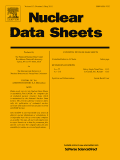
NUCLEAR DATA SHEETS
Exploring the Frontiers of High-Energy Physics.NUCLEAR DATA SHEETS is a premier journal published by Academic Press Inc. Elsevier Science, dedicated to advancing the field of nuclear and high-energy physics. With an impressive impact factor and a distinguished Q2 ranking in the pertinent category as of 2023, this journal is recognized for its significant contributions to the synthesis and dissemination of nuclear data, serving as an essential resource for researchers, professionals, and students alike. The journal has been in continuous publication since 1971, making it a cornerstone of knowledge in the discipline as it converges into 2024. Researchers can explore a plethora of meticulously curated articles that cover the latest findings, theoretical advancements, and experimental results in nuclear data, with the objective of fostering collaboration and innovation within the scientific community. While currently not open access, its publications are accessible through institutional subscriptions, ensuring a wide reach amongst academic and research institutions worldwide. With a high Scopus rank of #10 out of 87 in its field, NUCLEAR DATA SHEETS remains an authoritative source that is instrumental in shaping the future of nuclear physics research.
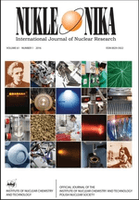
NUKLEONIKA
Advancing the Frontiers of Nuclear ScienceNUKLEONIKA, published by SCIENDO, is a leading open access journal that has been serving the scientific community since its establishment in 1968. Focused on the domains of Nuclear and High Energy Physics, Condensed Matter Physics, and Nuclear Energy and Engineering, this journal provides a platform for innovative research and technological advancements in a variety of interdisciplinary fields. With an impressive history of publications and a current Q3 ranking in several categories, including Safety, Risk, Reliability and Quality and Waste Management and Disposal, NUKLEONIKA is recognized for its significant contributions to scientific discourse. Open access since 2014, the journal ensures that all research outputs are freely available, facilitating broad dissemination and accessibility for researchers, professionals, and students alike. Located in the heart of Warsaw, Poland, NUKLEONIKA aims to inspire collaborative efforts and foster a deeper understanding of complex physical phenomena and their practical implications.
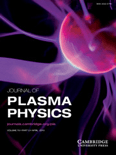
JOURNAL OF PLASMA PHYSICS
Transforming ideas into groundbreaking plasma research.Welcome to the JOURNAL OF PLASMA PHYSICS, a premier publication dedicated to advancing understanding and research in the field of plasma physics. Published by Cambridge University Press, this journal has been a pivotal resource since its inception in 1967, supporting scholars and professionals engaged in the innovative exploration of plasma phenomena. With an impressive Q1 rating in Condensed Matter Physics, the journal not only holds a significant position in the academic community but also ranks within the top 50th percentile in the Scopus database. Although it currently does not offer open access, the journal provides a wealth of valuable research contributions aimed at fostering knowledge and collaboration among researchers, professionals, and students alike. The Journal of Plasma Physics is committed to publishing high-quality articles that push the boundaries of knowledge, ensuring its vital role in the ever-evolving landscape of physics research.
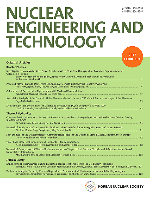
Nuclear Engineering and Technology
Unleashing Potential: Your Gateway to Nuclear ResearchNuclear Engineering and Technology, published by the Korean Nuclear Society, is a premier Open Access journal dedicated to the rapidly evolving fields of nuclear energy and engineering. Established as a significant platform for scholarly communication since 2008, this journal has consistently anchored itself in the academic community, achieving a Q2 ranking in its category as of 2023, reflecting its influence and quality within the domain of Nuclear Energy and Engineering. With an impressive Scopus ranking of #15 out of 77, positioning it in the 81st percentile, the journal publishes cutting-edge research that addresses both fundamental and applied aspects of nuclear technology. Nuclear Engineering and Technology embraces an open access model since 2013, ensuring that valuable research is accessible to a global audience, thereby enhancing collaboration among researchers, professionals, and students passionate about advancing nuclear technology. The journal serves as an essential resource for those aiming to innovate and push the boundaries of knowledge in nuclear sciences.

BRAZILIAN JOURNAL OF PHYSICS
Championing High-Quality Research in PhysicsBRAZILIAN JOURNAL OF PHYSICS, published by SPRINGER, is a prominent platform dedicated to the dissemination of research within the realm of physics and astronomy. With an ISSN of 0103-9733 and E-ISSN of 1678-4448, this esteemed journal has been contributing to the field since its inception in 1996, and it continues to be pivotal in showcasing innovative studies and breakthroughs. The journal is categorized in the Q4 quartile for the year 2023, reflecting a dedicated focus on advancing knowledge across a variety of disciplines, particularly in general physics and astronomy, where it ranks 126th out of 243 in Scopus rankings. Although it currently does not operate under an open-access model, it remains an invaluable resource for researchers, professionals, and students eager to enhance their understanding of complex physical principles and developments. The journal is committed to promoting high-quality research, bridging gaps in knowledge, and fostering collaboration within the global physics community.

Plasma
Unlocking the Potential of Plasma ApplicationsPlasma is a leading open-access journal published by MDPI, devoted to the exploration and advancement of knowledge in the fields of engineering, physics, and materials science. Established in 2018, this journal provides a vital platform for researchers, professionals, and students to disseminate original findings and critical reviews related to plasma science, its applications, and its interdisciplinary aspects. With an E-ISSN of 2571-6182, Plasma actively promotes open access to ensure that research is widely accessible, reinforcing its commitment to accelerating scientific communication and collaboration across global communities. The journal enjoys respectable rankings in Scopus, with a notable position in Engineering, Physics and Astronomy, and Materials Science categories, making it an essential resource for those seeking to remain at the forefront of plasma research. Covering a range of topics until 2024, Plasma invites cutting-edge contributions that push the boundaries of understanding in this dynamic field.
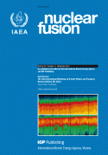
NUCLEAR FUSION
Advancing the frontiers of fusion energy research.NUCLEAR FUSION is a prestigious academic journal published by IOP Publishing Ltd, dedicated to advancing the field of nuclear and high-energy physics. With a significant impact factor and recognized among the top-tier journals, it boasts a Q1 ranking in both Condensed Matter Physics and Nuclear and High Energy Physics as of 2023. This journal, which has been published continuously since 1969, serves as a vital platform for researchers, professionals, and students exploring the latest advancements in fusion energy, plasma physics, and the intricate phenomena associated with high-energy states of matter. By disseminating original research, comprehensive reviews, and interdisciplinary studies, NUCLEAR FUSION strives to foster innovation and collaboration in pursuit of sustainable energy solutions, contributing significantly to the scientific community’s understanding of nuclear fusion processes. While the publication offers access options that enhance its reach, its rigorous peer-review process ensures the highest quality of scholarly communication.
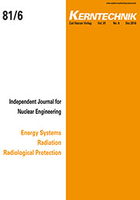
KERNTECHNIK
Connecting theory and practice in nuclear engineering.KERNTECHNIK is a distinguished journal specializing in the fields of Materials Science, Nuclear and High Energy Physics, and Nuclear Energy and Engineering. Published by WALTER DE GRUYTER GMBH, this journal has continuously contributed to advancing knowledge and research in nuclear technologies and related safety measures since its inception in 1969. With an ISSN of 0932-3902 and an E-ISSN of 2195-8580, KERNTECHNIK serves as a vital platform for academics and professionals seeking to delve into both theoretical and practical aspects of nuclear science and technology. Though listed in the Q4 quartile across multiple categories in 2023, the journal's commitment to publishing rigorously peer-reviewed articles ensures that it remains a respected resource, facilitating academic discourse and innovation. It is particularly aligned for those conducting research or working in safety, risk, reliability, and quality within the nuclear sector, and its extensive historical archive allows for in-depth exploration of evolving technologies. Aimed at foster cooperation between researchers, policymakers, and industry experts globally, KERNTECHNIK continues to play an important role in shaping the future of nuclear science.

Recent Contributions to Physics
Championing open access to transformative physics insights.Recent Contributions to Physics is a distinguished journal published by AL-FARABI KAZAKH NATIONAL UNIVERSITY, focusing on the latest developments and research breakthroughs in the field of physics. Established as an open access journal since 2008, it aims to facilitate the wide dissemination of knowledge by allowing researchers, professionals, and students worldwide to access high-quality content without barrier. Featuring a diverse range of topics within physics, from theoretical innovations to practical applications, this journal is an essential resource for anyone seeking to stay at the forefront of scientific advancement. Its commitment to quality and accessibility not only enhances the impact of research in the scientific community but also promotes collaboration across disciplines. With its dedication to fostering a vibrant academic dialogue, Recent Contributions to Physics is poised as a key contributor to the future of physics research.